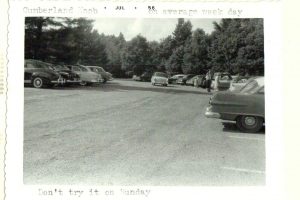PREVIOUS: Economy and Culture

“Cumberland Knob on average week day… Don’t try it on Sunday.” Photograph Courtesy of the Blue Ridge Parkway Photo Library [3]
But with all this talk of tourism, what exactly is it about the Parkway that draws tourists to migrate on it? The BRP offers many wonderful attractions for tourists. Some of these features—such as leaf-looking, hiking, and camping—speak to the natural allure of the Parkway and the Blue Ridge Mountains. Other activities, such as cycling, motorcycling, and photography, highlight commercial uses of the BRP. Both natural and commercial tourism play a role in understanding the overall tourist usage of the great scenic highway and will be explored in “Tourists.”
UP NEXT: Commercial
Footnotes
[1] “Downtown Asheville Historic District– Asheville, North Carolina: A National Register of Historic Places Travel Itinerary,” National Parks Service, accessed October 29, 2017, https://www.nps.gov/nr/travel/asheville/dow.htm.
[2] “Battery Park Hotel– Asheville, North Carolina: A National Register of Historic Places Travel Itinerary,” National Parks Service, , accessed October 29, 2017, https://www.nps.gov/nr/travel/asheville/bat.htm.
[3] “Parking on Average Weekday,” Cumberland Knob, milepost 217.5, photographer Roscoe Reeves, July 1956, Blue Ridge Parkway Photo Library, Blue Ridge Parkway Headquarters, Asheville, North Carolina.
[4] Fred L. Weede, “ Battle for the Blue Ridge Parkway,” 1957, courtesy of Buncombe County Library, Blue Ridge Parkway Archives, Asheville, North Carolina.
